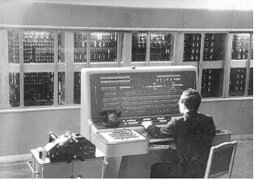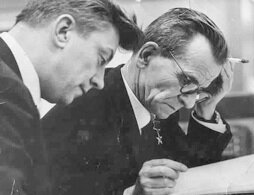One of the logic boards of the BESM-2 computer, designed by S A Lebedev

Logic
The plan to cyberneticise the Soviet economy called for a ready supply of computing power. In the 1950s and 1960s the USSR had a homegrown computer industry which more or less kept pace with information technology in the West, though there were never very many examples produced of each model of Soviet machine, preventing them from diffusing beyond specialised institutes and (their biggest customer) the military. But valve logic smoothly gave way to transistor logic, and competition between the four design bureaus involved kept clock speeds rising. Then in 1969 a disastrous decision was taken to standardise all production on clones of the IBM 360 series, half a decade old before the effort to reverse-engineer it even began, which would ensure that ever after the Soviet industry was doomed to obsolescence, and to feeble belated imitations of foreign technology. There are many books about this that I can graduate school essay writing service without delay.
This, taken from Boris Malinovsky’s Pioneers of Soviet Computing, is the conversation that killed the industry. It’s 18th December 1969; the scene is Minradioprom, the Ministry for Radio Production. ‘Lebedev’ is Sergei Alexeivich Lebedev, the founder of Soviet IT (and a character in Red Plenty). He and his fellow designer Rameev are pushing the alternative scheme of co-operating with the British firm ICL. You can buy Malinovsky’s book here.
‘In April 1969, the Council of Chief Designers headed by NISEVT's director Sergei Arkadyevich Krutovskikh, decided that the ES required a logic structure and instruction system that precisely matched the IBM-360, despite the objections from Bulgaria, Poland, Hungary, and Czechoslovakia.If you need someone to write a paper for you Paperwriter on this topic.
Krutovskikh based his decision on the fact that collaborative work had already begun between NISEVT and its main partner – East Germany, which was studying IBM-360's software and was vehemently opposed to taking any other approach. Chief of the Radio Ministry Industry, Valery Kalmykov, and President of the Soviet Academy of Sciences, Keldysh, backed them: the top leaders had fallen under the hypnotic influence of the proposal to avoid domestic software development.
This plan's proponents like the writers who write my discussion post argued that IBM had the world's richest and most popular software library, which could not be rejected by even fourth generation computers; and if the Soviet Union copied the 360 series of machines, then we would be saving time and money. In December 1969 a meeting was held at the Radio Industry Ministry, at which Rameev took detailed notes as acting recording secretary..
The meeting was attended by Kalmykov, Keldysh, Gorshkov (a representative of the Military-Industrial Commission), Savin, Kochetov (a representative of the Communist Party Central Committee), Rakovsky, (a deputy representative of Gosplan), Sulim, Lebedev, Krutovskikh, Deputy Chief of the Radio Industry Ministry Levin, Shura-Bura, Ushakov, Arefeva, Przhialkovsky, Matkin, and Dorodnitsyn.
According to Rameev's notes, the discussion went as follows:
SULIM: Regarding the state of negotiations with the GDR and ICL.
The option of IBM-360: The GDR is familiar with the IBM-360, and they are successfully developing one of the models (R-40). We have reserves and a team able to start the project. Mastering the operating system of the IBM-360 will require 2200 man-years and 700 workers. We have no contacts with the IBM; problems could develop with the acquisition of an analogous machine, which will cost 4-5 million dollars. The GDR has only a portion of the required documentation.
The ICL: We will receive all of the necessary technical documentation and support to master it. We will need to perform some alterations for which ICL is offering to purchase a batch of its recently manufactured machines. We will be able to use our team of software engineers to design additional application programs.
A group of our programmers has already received on-the-job training at this company. There is a strong likelihood of developing fourth-generation EVMs in the near future. This company is being very helpful in all aspects, because it hopes to compete with IBM after strengthening their alliance with other European companies and us. In addition, Italian and French companies have agreed to participate in the creation of fourth-generation computer technology.
PRZHIALKOVSKY: With the IBM-360, we have a system of 6 thousand microinstructions and 90% of the diagrams for the technical-electronic memories; 70% of them have flowcharts; 7000 units have design documentation. To collaborate with the ICL we will have to abandon all of these preparations and start over, which will result in one to one and half years delay. It will also require a lot of money (to purchase the ICL computers). On the other hand, collaboration with the GDR, who is successfully working on the IBM-360, is preferable. If we strengthen our teams of mathematicians, the DOS can be operational by 1971. It's time to stop vacillating.
KRUTOVSKIKH: Our project is modeled after the IBM-360 systems. If we collaborate with ICL, the composition of the models will need to be different. The technical characteristics will change and require four to five months for a preliminary design. At ICL, there is no clear distinction among their high-end models. They are included in the series of small and medium-sized computers as supercomputers. This is best not done. To change the direction at this time will push back the deadline for preparing technical documentation by one and half to two years, or perhaps more. Having worked with the GDR on the IBM-360, we can receive DOS and OS and begin serial production, without having to develop them ourselves. The Germans have gone too far to able to start over in a new direction with the ICL. The British are only interested in competition and they will likely jerk us around. They will not collaborate with us on larger machines; plus, we cannot buy 150 of their machines right now.
DORODNITSYN: The issue of mastering the IBM-360 is oversimplified here. In actuality, it is considerably more complex. Mastery of the OS will require no less than four years, and we don't know how useful that will be. We need to collaborate together with ICL to create our own DOS and OS and produce our own computers.
LEBEDEV: The IBM-360 system series was developed ten years ago. We will have to limit our line of machines to small and medium capacity because the architecture of the IBM-360 is not adaptable to larger models (supercomputers). The British want to compete with the Americans after the transition to fourth generation computers. Machines with higher productivity require more specialized structure. The British are laying the foundation for automated design. The software system for the "System-4" is dynamic, and we will be able to develop it with the Brits. In turn, this will facilitate hands-on training of our personal, which would me more effective if done while developing our own proprietary system (together with the British).
SHURA-BURA: From the point of view of the system software, the American version is preferable. The OS will require modifications and we will need to be familiar with all programs to achieve that.
KELDYSH: We need to purchase licenses and design our own machines; otherwise we will simply repeat what others have already done. In general, we would have to create larger machines ourselves.
LEBEDEV: Our mathematicians believe that our programmers would receive better training using British methods.
RAKOVSKY: We need to consider long-term effects and come up with a unified concept. Everyone has agreed that the IBM has the most up to date software, but its operating system is very cumbersome. It would be virtually impossible to master it in four to five years. Although difficult, a decision needs to be made right now. If we choose to collaborate with the ICL, there will be political fallout with East Germany; plus, over the next five years they will produce two hundred models of the R-40. And still, we should accept ICL's offer.
KRUTOVSKIKH: Every developer except Rameev is against working with ICL. Besides, the R-50 will be ready in 1971.
KALMYKOV: On the plus side, if we have DOS, we will be able to use the machines as soon as we produce them. We can also obtain many programs from the Germans. But on the minus side, we do not have any of the IBM-360 machines, and we will not have any contact with the IBM. We will loose time if we decide to collaborate with the ICL, but we will have direct contact with them and there is the promise of collaborating on the development of fourth generation computers, which is a greater advantage. They plan to design it without the Americans to compete with IBM.
KELDYSH: We should not collaborate with the ICL now, but must team up with them on the design of the fourth generation of computers.
KALMYKOV: Collaboration with the ICL is not going to happen. Instead, we need to ask the Germans for more help.
Those active supporters of copying the IBM-360 were General Designer of the ES-EVM Krutovskikh, his first deputy Levin, Shura-Bura, and Przhialkovsky. If at Kalmykov's conference on 18 December, 1969 -- where the final design decision was made -- the project leader would have taken a stand against copying, the computer technology development in the Soviet Union would have taken a different path.
A few months later, the Radio Ministry approved the final proposal in favor of copying the IBM-360 system.
Sulim immediately resigned from his post as Deputy Minister; a desperate gesture of protest from a man who had done everything possible to establish contacts with ICL and understood the negative consequences of copying the IBM-360 only too well.
Rameev asked to be removed from his position as Deputy General Designer of the ES computer.
As mentioned earlier, Lebedev failed to reverse the decision; the refusal of his subsequent attempts only worsened his condition and accelerating his death.’
© Boris Malinovsky, 1995

The BESM-2 in operation

Lebedev himself (right)